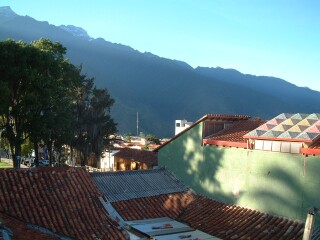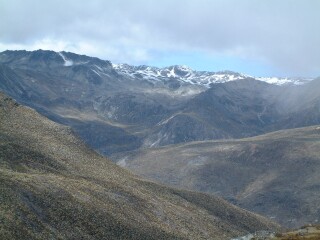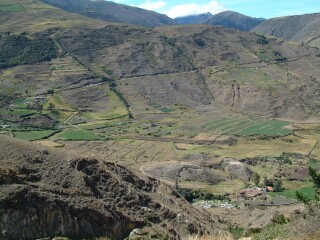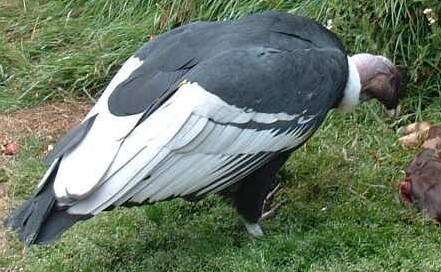

 One
problem with us going up to Mérida, and especially going above it, is altitude
sickness. The problem is that after so long at sea level, there is a lot of
nitrogen in our bloodstreams, but it is completely dissolved. We are also
getting a lot of oxygen in each breath. As the air gets thinner, there is a lot
less oxygen in each breath, so you get tired faster. More importantly, the lower
atmospheric pressure combined with the high nitrogen content of your blood makes
it harder for your body to utilize oxygen. When combined with low oxygen levels,
this condition can cause your cells to lose oxygen and fill up with water. This
can cause symptoms ranging from dizziness and shortness of breath through nausea
and heavy coughing, and can finally result in death due to brain and/or lung
damage. The solution, known as acclimatization, is to increase altitude
gradually, increasing your oxygen intake and getting rid of excess nitrogen as
you exhale.
One
problem with us going up to Mérida, and especially going above it, is altitude
sickness. The problem is that after so long at sea level, there is a lot of
nitrogen in our bloodstreams, but it is completely dissolved. We are also
getting a lot of oxygen in each breath. As the air gets thinner, there is a lot
less oxygen in each breath, so you get tired faster. More importantly, the lower
atmospheric pressure combined with the high nitrogen content of your blood makes
it harder for your body to utilize oxygen. When combined with low oxygen levels,
this condition can cause your cells to lose oxygen and fill up with water. This
can cause symptoms ranging from dizziness and shortness of breath through nausea
and heavy coughing, and can finally result in death due to brain and/or lung
damage. The solution, known as acclimatization, is to increase altitude
gradually, increasing your oxygen intake and getting rid of excess nitrogen as
you exhale.
 We
had wanted to go up the Teleférico (cable car) from Mérida (about 6,000 feet)
to the top of one of the nearby peaks (15,633 ft,) but the altitude shift could
be dangerous if we went to soon. To help us acclimatize, and to see more of the
surrounding area, we took a tour in a van with Victor.
We
had wanted to go up the Teleférico (cable car) from Mérida (about 6,000 feet)
to the top of one of the nearby peaks (15,633 ft,) but the altitude shift could
be dangerous if we went to soon. To help us acclimatize, and to see more of the
surrounding area, we took a tour in a van with Victor.
We saw much of the countryside called El Paramo around Mérida, going up onto the highest road in Venezuela, Paso El Aguilla (about 11,00 ft, not as high as the Teleférico) and exploring the little towns sprinkled across the mountainsides. We ate lunch at a small, high-altitude (and very cold) restaurant near a nice lake. I had fried trout with garlic, and it was delicious. After lunch, we explored the lake. It felt strange to want to run around the open field, but get out of breath after climbing a small hill.
 The
views were worth it, however. From the roads, we could see verdant green cloud
forests, where the mist hangs around the plants and gives them their moisture
directly. The dense mosses and ferns reminded me of our mountains at home. Other
places, we could see small villages and farms. Andean farmers have perfected the
growing of crops in steep, rocky hillsides; they create small terraces, using
rock walls to hold them in place. The principal crops I saw were potatoes, of
several varieties. In some places, there would be perhaps thirty or forty people
working one field, digging up potatoes to form piles of them taller than I am.
The villages were similar, with most structures made of rock or cement, and all
flowing down the hillside, as if grown out of it. The nicest scenery, however,
was where we could look up the mountains and see their glittering, snowcapped,
craggy peaks, or down steep mountainsides into green valleys.
The
views were worth it, however. From the roads, we could see verdant green cloud
forests, where the mist hangs around the plants and gives them their moisture
directly. The dense mosses and ferns reminded me of our mountains at home. Other
places, we could see small villages and farms. Andean farmers have perfected the
growing of crops in steep, rocky hillsides; they create small terraces, using
rock walls to hold them in place. The principal crops I saw were potatoes, of
several varieties. In some places, there would be perhaps thirty or forty people
working one field, digging up potatoes to form piles of them taller than I am.
The villages were similar, with most structures made of rock or cement, and all
flowing down the hillside, as if grown out of it. The nicest scenery, however,
was where we could look up the mountains and see their glittering, snowcapped,
craggy peaks, or down steep mountainsides into green valleys.
We visited some landmarks as well. We saw statues, graves, and shrines of people from Mérida's past, and learned their stories. For example, there was one statue of a woman with her arm stretched out and her finger extended, searching for something. Victor told us her name was Luz Caraballo, and she was searching for her children. One of her daughters had married and moved away, another had died, and her three sons were part of Bolivar’s army and may have died. Supposedly, in her grief she had searched all over Mérida, looking for them.
 One
of the most interesting parts of the tour was the condor research and
reintroduction facility. The Andean Condor, which is actually a very large kind
of vulture, is almost extinct, and the purpose of this project is to bring them
back and educate people in protecting them. They had an adult male and female at
the facility, and several booklets, films, and explanations about the huge
birds. The birds themselves had the featherless heads and large, strong beaks of
vultures. They flew rather awkwardly, but that may have been caused
intentionally, or the result of an old injury. The center had a lot of
information about the birds and what had pushed them near extinction, and
appeared to be working to educate the public about reintroducing and preserving
the condors. I was impressed by their conservation efforts, and learned some
very interesting things.
One
of the most interesting parts of the tour was the condor research and
reintroduction facility. The Andean Condor, which is actually a very large kind
of vulture, is almost extinct, and the purpose of this project is to bring them
back and educate people in protecting them. They had an adult male and female at
the facility, and several booklets, films, and explanations about the huge
birds. The birds themselves had the featherless heads and large, strong beaks of
vultures. They flew rather awkwardly, but that may have been caused
intentionally, or the result of an old injury. The center had a lot of
information about the birds and what had pushed them near extinction, and
appeared to be working to educate the public about reintroducing and preserving
the condors. I was impressed by their conservation efforts, and learned some
very interesting things.
After spending almost the whole day on the tour, we were all tired when we returned to our posada. For dinner, we went to a pizzeria right next door, and went back to our rooms as soon as we were finished. Before we went to sleep, we began preparations to go up the Teleférico the next day.
Top Level: Home | Destinations | Cruising Info | Underwater | Boat Guests | Ocelot | Sue | Jon | Amanda | Chris | Site Map | Make a Comment
|
If our information is useful, you can help by making a donation |
Copyright © 2000‑ Contact: Jon and Sue Hacking -- HackingFamily.com, svOcelot.com. All rights reserved.